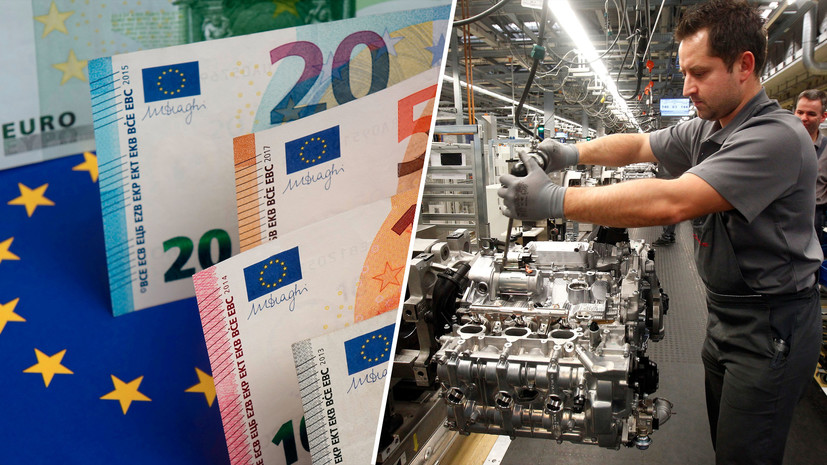On Monday, September 23, the euro is showing a significant weakening in the global currency market. Thus, the exchange rate of the single European currency to the US dollar is being traded near the minimum mark since the spring of 2017 - $ 1.09 per euro.
Investors reacted negatively to statistical data on the state of the eurozone industry. In September, the index of business activity (PMI) in the manufacturing sector of the region dropped to a minimum since November 2012 and amounted to 45.6 points. This is stated in the report of the analytical agency IHS Markit.
Industrial dynamics deteriorated immediately in the two largest economies in Europe. So, in France, the PMI index fell record high over the past four months (to 50.3 points), while in Germany the figure reached the lowest level since July 2009 - 41.4 points.
Traditionally, the PMI index reflects the real state of a particular industry. A value above 50 points indicates a positive economic situation, below 50 points - the stagnation of the sector.
“Germany’s performance is terrifying. The uncertain prospects of trade wars, the development of the automotive industry and Brexit paralyzed the growth of new industrial orders. September was the worst since the 2009 global financial crisis, ”says Phil Smith, IHS Markit Chief Economist.
The fall in German business activity turned out to be worse than forecasted and runs the risk of leading to a full-blown recession in the main eurozone economy. This was in an interview with RT, said analyst at Freedom Finance Investment Company Alen Sabitov. According to the German Federal Bureau of Statistics, from April to June, the country's GDP has already declined by 0.1%. Moreover, the indicator may continue to fall in the coming months.
“In addition to the deterioration of industrial PMI in Germany, business activity in the service sector is also declining. Such dynamics suggests that the most likely scenario will be a decrease in the growth rate of the German economy in the third quarter. The second consecutive quarterly decline in GDP will technically mean a recession in the country, ”Alain Sabitov explained.
Experts attribute the worsening economic situation in Germany and France to the US trade wars. In June 2018, the States began levying duties on European steel and aluminum goods imported into the country. The EU imposed reciprocal restrictions, after which Washington threatened to impose tariffs on European automotive products. New measures are expected to take effect in November 2019.
“The economies of Germany and France are heavily dependent on exports: its share in the GDP of both countries is 47% and 39%, respectively. The higher this dependence remains, the stronger will be the negative reaction to American restrictive measures, ”Gennady Nikolaev, an expert at the Academy of Financial and Investment Management, explained to RT.
The general situation is aggravated by the US conflict with Iran. Vyacheslav Abramov, director of the BCS Broker sales office, in an interview with RT added that Washington’s sanctions against Tehran adversely affect the work of all European companies in the Islamic Republic.
According to analysts, a decrease in business activity at the same time in France and Germany could lead to inhibition of the entire economy of the eurozone. However, the European Central Bank (ECB) has already lowered its forecast for GDP growth in the region in 2019 - from 1.2% to 1.1%, and in 2020 - from 1.4% to 1.2%.
“The fall in the index of business activity in the two largest economies in the eurozone creates a domino effect for all other countries of the association. In the second quarter, the manufacturing sector in the region fell 1% and hit the labor market noticeably. The resulting risk of a contraction in the eurozone economy in the coming months gives investors a reason to reconsider their investments, ”said Artyom Deev, head of the AMarkets analytical department, in a conversation with RT.
According to Alena Sabitova, in the second half of the year, Eurozone GDP growth may be close to zero. According to the analyst, the ECB could support the economy of the region.
On September 12, regulator head Mario Draghi has already announced the launch of a quantitative easing program. The ECB intends to turn on the printing press and buy up government bonds of eurozone countries with the money issued. The actions of the Central Bank lead to an increase in the money supply in the region, allow to accelerate inflation and increase the rate of GDP growth. At the same time, quantitative easing traditionally provokes a weakening euro in the long run.
“Low growth rates and a soft monetary policy in response to this can help maintain the weakness of the European currency. The corresponding exchange rate to the US dollar may fall to the levels of $ 1.06-1.08 per euro. For the Russian currency, this will mean a depreciation of the euro to 68–69 rubles, ”Alen Sabitov concluded.

